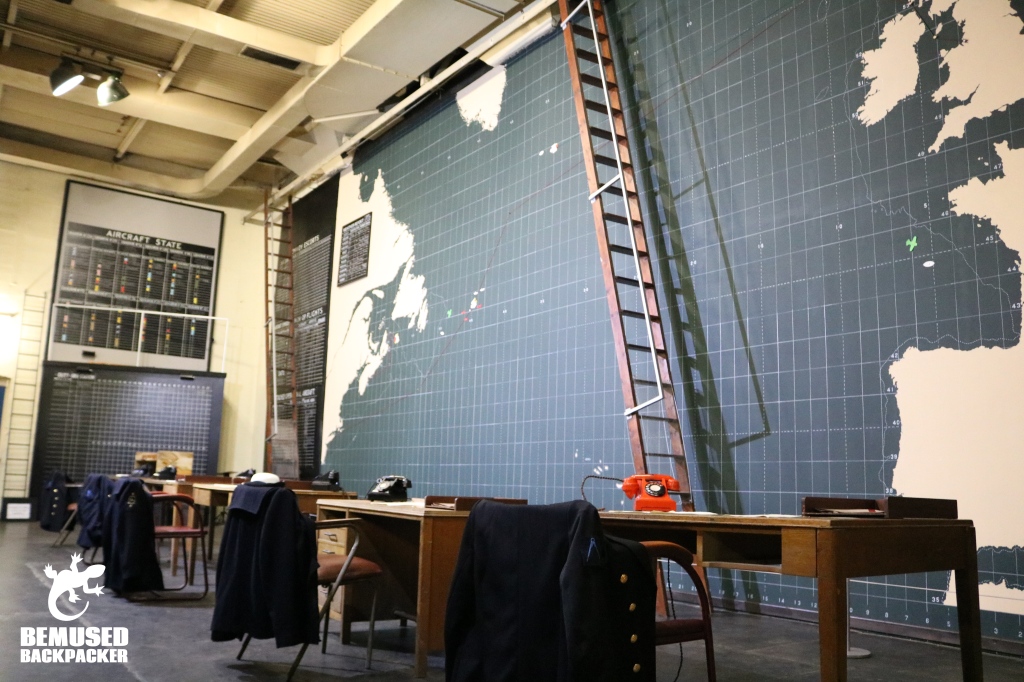
The Western Approaches Museum is one of Liverpool’s best kept secrets! A hidden secret underground WWII bunker that once played a vital role in the Battle of the Atlantic and is now a living museum that celebrates Liverpool’s role in wartime history.
This is a paid article written in partnership with Visit Liverpool with products or services supplied by them. Full editorial integrity is maintained at all times. The views and opinions expressed are entirely the authors own based on personal experiences when travelling and are honest and factual without any bias.
A ‘hidden gem’ is a bit of a cliche in tourism, but in this case it is literally true. Hidden away in a nondescript street in Liverpool is Derby House, an art deco, 1930s office block that whilst aesthetically beautiful, blends into its surroundings and looks no different to any of its neighbours. It is easy to miss, easy to ignore, and that was once one of its biggest attributes.
What most people don’t know as they walk past, is that beneath their feet is a warren of tunnels and rooms that once made up one of Britain’s most important, top secret WWII bunkers, and that this once vital piece of wartime history has now been turned into one of Liverpool’s best kept tourism secrets.

Known as the Citadel, this bomb proof, gas proof 55,000 square feet concrete and steel bunker was the home of a specialist team of Royal Navy, Royal Air Force and Royal Marine personnel who played a vital role in the Battle of the Atlantic, stopped the German U Boat threat and ensured not only Britain’s connection to the US and Canada but its eventual victory over Germany in WWII.
Staffed almost entirely by the women who made up the Women’s Royal Naval Service and the Women’s Auxilliary Air Force, or Wrens and WAAFs for ease of use, the bunker monitored and protected the western approaches, the part of the Atlantic ocean off the western coast of Great Britain, making Liverpool one of the most strategic points of the UK during the second world war.
Living History.

Sealed away, hidden and forgotten for decades, the bunker has now been turned into a large, living museum. Carefully and lovingly restored from pieced together photographs and scattered evidence from people with a genuine passion and love for the history, the museum is genuinely a labour of love and a true homage to the past. With large parts of the bunker – like the Operations Room – set up exactly how it was when the doors were finally closed on the 15th August 1945, or as close as it can be being pieced together from old photographs and the few scraps of evidence available, I am really not exaggerating when I say this is truly a living piece of history and one that everyone should know about.
With a giant battle map pulling you straight back through time and the cypher room set up exactly how it would have been during the war, you can almost see and hear the ghosts of those who worked here frantically relaying top secret messages to central command and through to Bletchley Park. With the addition of a recreated Liverpool street scene from the 1940s near the close of the tour, the museum wants you to feel what life must have been like for those living through it, and makes that history more accessible and fun for the family.
Thankfully you don’t need to join the military and sign the official secrets act to enter the museum anymore, anyone can come and explore this hidden time capsule and I wholeheartedly recommend that you do. This is a truly special day out that relatively few people know about and one that will transport you back to a time when the blitz spirit ensured Liverpool helped to win the war.
The Tour.
Guided tours are able to be booked in advance but it is also possible to just wander at your leisure and take a self guided tour too. Self guided tours should take around an hour and a half on average but to be perfectly honest I could personally spend most of the day here just wandering through each room and soaking up the history and the wealth of information on display. It is a mark of a great attraction that I spent as much time as I could here and walked away feeling like I only scratched the surface and wanting to come back.
Entering the bunker itself is a slightly surreal feeling, there is no grand entrance or fanfare, just a rather nondescript room that could be any office lobby or retail back room in any building in the country. In fact in the years between the bunker being sealed up and now, that is pretty much what it was for most of the time, with the secrets below laying completely hidden away. As you head down a set of steel stairs however, that is when a real sense of solemn awe starts to build. You start to get a truer sense that this is not just a random shop or office building, this is a real military facility. You are actually walking through the same halls and doorways that were used by the staff of the Western Approaches Command over 80 years ago.
Helpful signs are there to create a sense of time and place, repeating wartime mantras that loose lips sink ships, and are there to remind you that this was once a military stronghold, and you hope you haven’t forgotten your pass ready for inspection.
At the start of your journey, a short video documentary is there to give you an overall picture of the road to war and the role Western Approach Command played in defeating Germany in WWII before you pass through to the central command area, and again there is a real sense that this is far more than just a museum, this is something special. There are no embellishments here, no fancy decoration just for effect, you are seeing a working bunker exactly the way the sailors and airmen would have seen it. Bunks are still made up, tables still have maps spread out on them ready for use, and then you are suddenly reminded of the poignancy of the fact that you are able to stand here and view this museum with a memorial for all those who served and lost their lives. An important reminder of the solemn reality of what transpired here before you carry on to the most impressive part of the whole museum. The Operations Room.
Painstakingly pieced together and reconstructed in as fine a detail as can be drawn out from old photographs and archive footage, the Operations Room was the nerve centre of the entire bunker.
The huge map on the wall is painted to match the one that would have originally been there, the markings on the blackboards recreated to match those in old photographs and constant detective work is still being undertaken to try and match original flags and markings to where they would have been placed during one of the many U boat attacks that took place on ships crossing the western approaches. As the information boards provide you with a wealth of knowledge and first hand stories, you can almost see the ghost of Admiral Horton looking down on the Command Centre in nothing but his pyjamas, having just been awoken from his adjoining bunk, at least you can do after reading one of the many information posts set up around the complex. After getting that image in your head, it is difficult to get rid of it!

What I loved about this museum is that it wasn’t just a ton of facts and information thrown at you, you did get that of course, but there was a tactile element to the tour that gives it a real sense of place. The typewriters on display are original vintage models from the 1930s and 1940s, and yet you can type away on them which as a writer myself was a bit of a thrill, but must give a whole extra dimension for children and families who come here, not to mention the hats and uniforms that are there for them to try on and the top secret folders to snoop through.
The sheer level of detail and work that has gone into this room, and the museum as a whole, is just staggering. This really is one of the single most unique attractions in the UK.

There are even more displays and further rooms celebrating the role of Captain Walker and the WRENS and WAAFs of WATU before you get to the signals and telephone exchange for a quick test of your phonic language and Morse code skills.

One of the best parts of the tour is the fact that the museum has the original Gaumont Kalee Dragon projector that was used to show secret war footage to Sir Winston Churchill himself right here. Most of the promotional footage shown to the public in cinemas would have first come through this very projector before being used by the Ministry of Information to boost morale.
It really is difficult to comprehend the importance of some of the artefacts and displays and the role they once played in British history, but that is truly part of what makes this museum special and fits in well with the quiet, unassuming British outlook.

The tour ends by a recreated street scene where the young, or young at heart, can try on a few vintage clothes and tin hats, next to the NAAFI (that’s the Navy, Army and Air Force Institition for all you civvies out there) canteen, where you can stop and get refreshments, but the best thing is it isn’t just recreated like a wartime military canteen, the prices are the same too! Where else can you get a cup of tea for just 2p? That will save you a ton of money you can spend at the gift shop when you go back up the stairs to the main entrance!

The self guided tour is just out of this world and it really does pay to just take your time, read the information on display, look at the displays and just reflect on the past, take a moment and just think of those who lived and worked here all those years ago, and I honestly cannot recommend doing this enough. But what you really should do is come twice, the first time for your own bit of self exploration and reflection, but the second time to take an actual guided tour. These have to be pre booked and come with a very reasonable price tag (even more so if you split the fee between a group), but are more than worth it. A self guided tour is good, but a tour with the in depth knowledge and stories of a really knowledgeable guide adds a whole new level to the tour itself. I spent just one visit here and genuinely feel like I missed so much, there is so much to see read and learn there is no way you can see it all in one go.
The Western Approaches Museum is a truly world class tourism attraction for all the family and is one of Liverpool’s best hidden gems in every sense of the word!
Booking.
The Western Approaches Museum recieves no government or charity funding, and all profits through tourism go into keeping the site open and running as well as the continued restoration of the bunker. This is why the money you spend here is so vital to the museum and how the positive impact of tourism can help keep this important piece of history alive for future generations.
The Western Approaches Museum tickets are valid for 12 months from the date of purchase and can be used as many times as you like. This makes them unbelievable value for money and personally I would still come more than once a year and be happy to pay the reasonable entry price each time, especially knowing that my money actually goes to help the upkeep of the museum and fund even further expansions in the future. It is a small price to pay to keep history like this alive.

The Western Approaches Museum is a fitting tribute not just to the past, but the role Liverpool played in it. It showcases the blitz spirit of the war and the bulldog spirit of the local people who helped to win it. To paraphrase Churchill himself after the Liverpool blitz of 1941, Liverpool is and always will be full of the spirit of an unconquerable people. I couldn’t agree more.
Much more than just a simple tourist attraction, the Western Approaches museum is also a warm memorial to all those who served and lost their lives in World War II, and a poignant reminder of the past that we must never forget.
That is why I urge everyone to visit this true hidden gem in Liverpool’s tourist attractions, to pay homage to those men and women who served here, to learn about our local history and the role Liverpool played in British history, and most of all, to enjoy one of the UKs best days out.
Did you enjoy this article? I would love to hear your thoughts in the comments section below or on my Facebook or Twitter pages and please feel free to share it with any or all of the social media buttons. If you want to get more great backpacking tips, advice and inspiration, please subscribe to updates via email in the box to your right.
Related Articles.
5 Free things to do in Liverpool.
Fall In Love With Liverpool On A 48 Hour City Break.
Going Back In Time At Blists Hill Victorian Town, Shropshire.





Love Liverpool and literally had no idea about this. Will put it on our list for when we next visit the city. Have you also been to the Williamson Tunnels? Equally fascinating in a different way and great value for money, also a charitable trust and I’d totally recommend.
I have, it was a long time ago though, but thanks for the suggestion it is definitely a worthy addition to any trip to the city!
What an amazing place! I had no idea!
A lot of people don’t!
Went here last week on your recommendation and it was as fantastic as you said. I had no idea of the part Liverpool played in the war and it makes me proud knowing this is right here in memory of all those who served. Well done for showing this amazing part of our heritage off to the world.
So glad you enjoyed your trip Carol, it is an amazing place with such an awesome and important history.
Been a few times now, taking full advantage of that free years membership. Such an amazing place.
It really is, and that free year on one ticket is so generous!
What a wonderful little museum! Will definitely make a point of coming to see this. Thank you.
You are more than welcome. Hope you enjoy it.
What about the “games” room where all the AS training took place?
All the original rooms have been made up and restored to how they would have looked